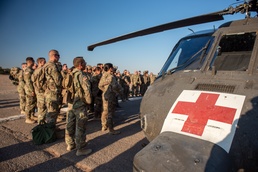
U.S. combat medic Soldiers in the 30th Armored Brigade Combat Team joined a Medical Evacuation (MEDEVAC) crew from 5th Armored Brigade, First Army Division West, to train on the critical skills of patient loading onto a UH-60 Black Hawk. The training took place just before sunset in the vicinity of Fort Bliss, Texas, September 3, 2019.
More than 50 combat medics from the North Carolina, South Carolina, Ohio and West Virginia Army National Guard, who comprise the 30th Armored Brigade Combat Team, practiced loading a teammate on a gurney using what is called a hot-load method. This means the helicopter rotors were turning when they approached it, as opposed to a cold-load when the engines are shut down on the helicopter.
U.S. Army Sgt. First Class Meredith Kiser, 30th Armored Brigade Combat Team Medical Operations Non-Commissioned Officer in Charge (NCOIC) said the exercise trained the combat medics on performing triage, treatment, and transport to a higher level of care. Kiser, who has deployed twice to Iraq, added they strive to train with Army aviation as much as possible because when troops are spread out, rotary-wing assets are the fastest method to get someone to treatment who is critically injured.
“Using an FLA (Field Litter Ambulance) is fine for shorter distances, but for major injuries it is better to transport with Army aviation,” said Kiser.
U.S. Army 1st Sgt. Alicia Faulk, a critical care nurse serving as an Observer/Controller Trainer (OCT) with 5th Armored Brigade, First Army Division West, said safety is their number one concern.
“They must be focused on safety when putting a patient on a litter, for example, using the proper straps,” said Faulk. “My role is to watch the interventions placed on the casualty and to see if they are doing it properly and if there are things they need to work on, talk about or improve.”
The combat medics rotated in teams, approaching the MEDEVAC helicopter as the rotors turned, stirring up rocks and dust. Some of the medics were able to test the hoist attached to the helicopter, which is used for rescues and extractions.
U.S. Army 2nd Lt. Alisa Stoddard, the 30th Armored Brigade Combat Team Medical Operations Officer said the overall goal was to synchronize the skills of the combat medics who serve in different battalions in their respective National Guard states that encompass the 30th Armored Brigade Combat Team.
“Everybody brings something with different backgrounds and experiences,” said Stoddard. “It was great getting the medics together and on the same page, especially as we move forward as one big team.”
The 30th Armored Brigade Combat Team is mobilized for approximately a year to support Operation Spartan Shield in the Middle East.